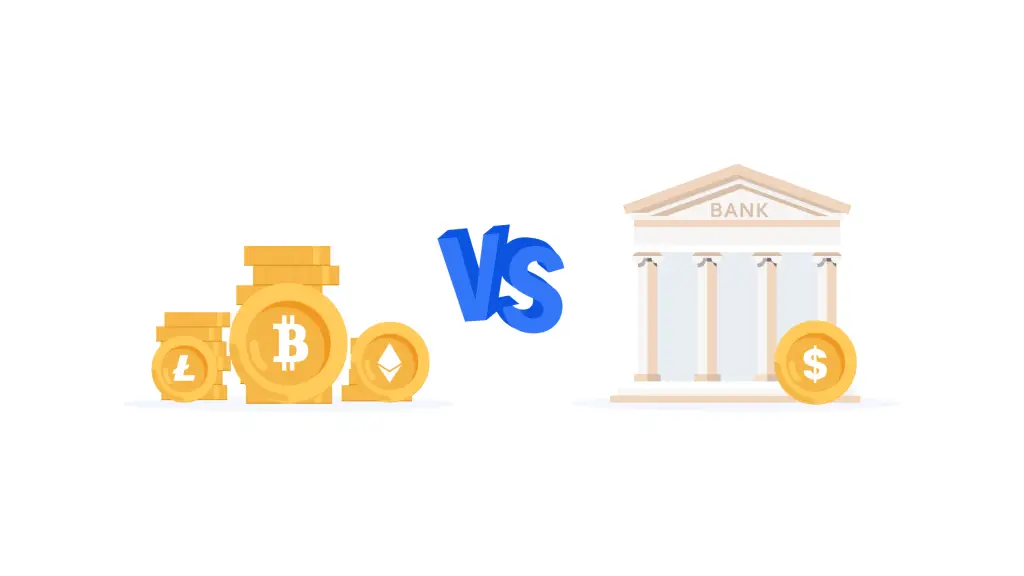Table of Contents
Introduction – Crypto vs Traditional Banking
“Crypto vs Traditional Banking”. The financial landscape has undergone a seismic shift with the advent of cryptocurrencies, presenting an intriguing comparison to traditional banking systems. Both realms embody distinct philosophies and functionalities, shaping the way we perceive and interact with financial services. This article delves into the intricacies of Crypto vs Traditional Banking, exploring their histories, principles, and the evolving nature of money and transactions in the digital age.
Historical Development
Traditional banking’s roots can be traced back centuries, marked by the evolution of monetary systems and financial institutions. In contrast, the world of cryptocurrencies is relatively nascent, born from the digital revolution. Understanding their origins offers insight into their current structures and philosophies.
Core Principles and Functioning
At its core, traditional banking operates on centralized systems, governed by regulatory bodies and financial institutions. Cryptocurrency, however, thrives on decentralization, with blockchain technology at its heart. These foundational principles dictate their operational mechanisms, security protocols, and user experiences.
Security Aspects
Security remains a paramount concern in both domains. Traditional banking has evolved robust regulatory and security measures to protect customer assets. Cryptocurrencies offer a different approach to security, leveraging blockchain technology to provide a secure and transparent transaction environment.
Accessibility and Inclusivity
Traditional banking has a significant global footprint, yet faces challenges in reaching the unbanked populations. Cryptocurrencies emerge as a potential solution to this problem, offering greater inclusivity and accessibility through decentralized networks.
Transaction Speed and Efficiency
While traditional banking transactions can be time-consuming, especially across borders, cryptocurrencies offer a stark contrast with their swift and efficient transaction capabilities, often completed in a matter of minutes.
Fees and Costs
The fee structures in traditional banking, encompassing various transaction and service fees, differ considerably from those in the crypto world, where transaction fees can be significantly lower, albeit subject to network congestion and other factors.
Regulatory Environment
The regulatory landscape for traditional banking is well-established, with clear guidelines and frameworks. Cryptocurrencies, however, are navigating a complex and evolving regulatory terrain, with varying approaches across different countries.
Anonymity and Privacy
Traditional banking systems require customer identification, adherence to strict KYC regulations. Cryptocurrencies offer varying degrees of anonymity, a feature that has been both lauded and criticized in equal measure.
Investment Opportunities
Both realms offer unique investment opportunities. Traditional banking provides time-tested investment avenues like savings accounts, stocks, and bonds. Cryptocurrencies have introduced a new, dynamic asset class, marked by high potential rewards but also significant risks.
Risks and Volatility
Traditional banking is not immune to risks, including credit, market, and operational risks. Cryptocurrencies, however, are particularly known for their high volatility, influenced by market sentiments, regulatory news, and technological advancements.
Technological Advancements
The integration of technology in traditional banking has led to enhanced services and customer experiences. Cryptocurrency, inherently tech-driven, continues to evolve, with blockchain technology leading the way in innovation.
Environmental Impact
The environmental implications of both systems are a growing concern. While the traditional banking sector’s impact is tied to physical infrastructure and operations, the environmental footprint of cryptocurrency, particularly in mining, has sparked widespread debate.
User Experience
The customer experience in traditional banking is characterized by physical and digital interfaces, evolving to meet modern consumer demands. Cryptocurrency offers a different user experience, centered around digital wallets and exchanges, demanding a certain level of tech-savviness.
Future Trends and Predictions
The future of traditional banking seems geared towards digital transformation and integration with emerging technologies. The cryptocurrency sector, meanwhile, is poised for further innovation, with potential mainstream adoption and integration into existing financial systems.
Global Economic Impact
Traditional banking continues to play a crucial role in the global economy, governing monetary policies and financial stability. Cryptocurrencies are beginning to leave their mark, influencing investment strategies, remittance flows, and even monetary policies in some regions.
Public Perception and Trust
Trust in traditional banking has been shaped by historical precedents, regulatory frameworks, and consumer protection laws. Cryptocurrencies face challenges in building public trust, grappling with misconceptions, and the need for greater understanding and education.
Conclusion
The journey of Crypto vs Traditional Banking reflects the evolving narrative of finance. As we move forward, it is clear that both will coexist, each playing a pivotal role in shaping the future of monetary transactions and financial services.
FAQs
- How does cryptocurrency differ from traditional banking in terms of transaction speed? Cryptocurrencies typically offer faster transaction speeds compared to traditional banking, especially for cross-border transfers. This efficiency stems from their use of decentralized blockchain technology.
- What are the security benefits of using cryptocurrency over traditional banking? Cryptocurrency transactions are secured by blockchain technology, providing a high level of security through encryption and decentralization, making them less vulnerable to centralized attacks or fraud.
- Can cryptocurrencies be regulated like traditional banks? The regulation of cryptocurrencies is more complex due to their decentralized nature. However, governments and financial authorities are increasingly working on frameworks to regulate crypto transactions and exchanges.
- Are cryptocurrencies more environmentally friendly than traditional banking? The environmental impact of cryptocurrencies, especially those relying on energy-intensive mining processes, is a concern. Traditional banking also has an environmental footprint, but the debate is ongoing regarding which is more sustainable.
- How accessible are cryptocurrencies compared to traditional banking? Cryptocurrencies offer increased accessibility, especially for people in regions with limited traditional banking infrastructure. They allow for direct peer-to-peer transactions without the need for a central authority.
- What are the risks of investing in cryptocurrencies compared to traditional banking products? Investing in cryptocurrencies carries higher risks, including high volatility and regulatory uncertainty, compared to traditional banking products, which are generally more stable and regulated.
Conclusion The dialogue between Crypto and Traditional Banking is more than a comparison; it’s a reflection of our evolving relationship with money and technology. Each system has its merits and challenges, and understanding these is key to navigating the future of finance.

